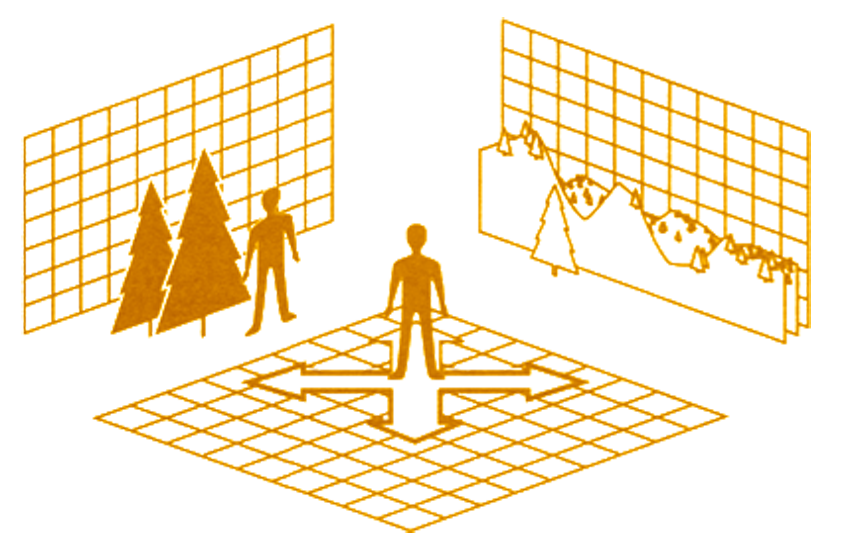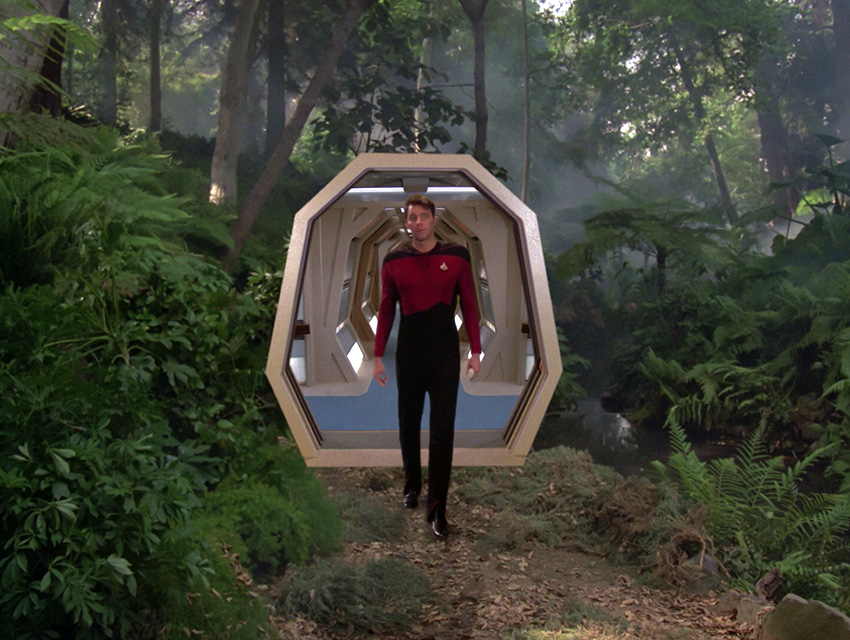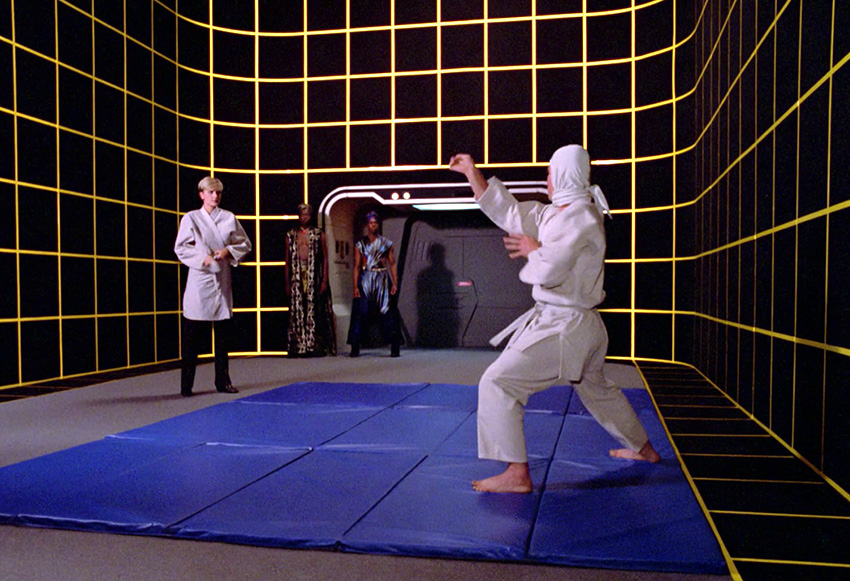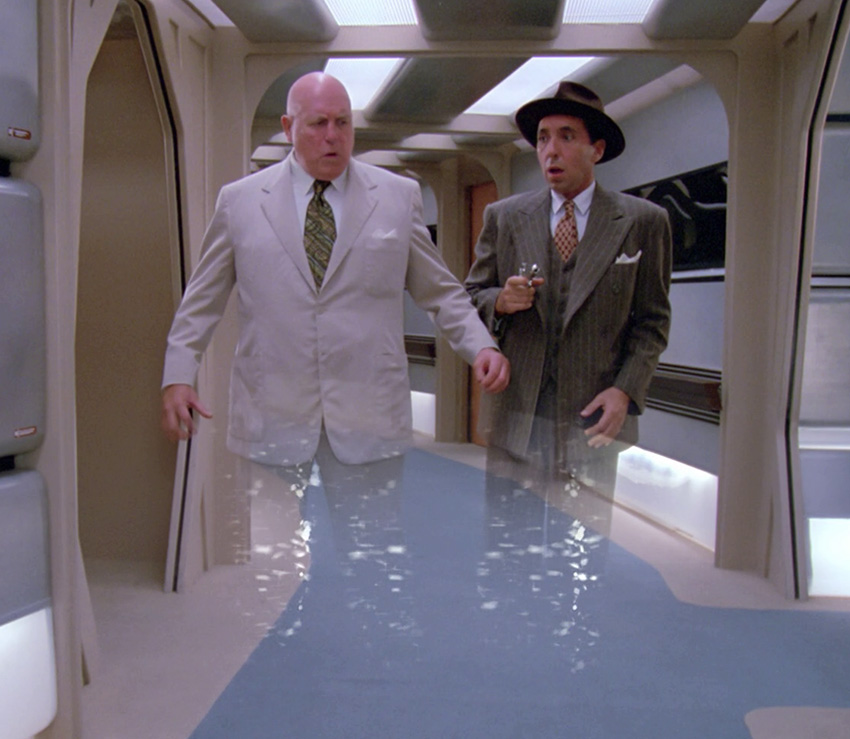Introduced in the first episode of Star Trek : The Next Generation, “Encounter at Farpoint”, the holodeck is a large room on the ship which can produce a simulation of any given environment - a desert, a leafy forest, a city, whatever the computer has a program for. How it does this is described thusly :
| Riker : | "These simulations seem so real." |
| Data : | "Much of it is. If the transporters can convert our bodies to an energy beam and then back…" |
| Riker : | "Yes. Rocks and vegetation have simpler patterns." |
| Data : | "Correct, sir.” [gestures] “The rear wall." |
| Riker : | "I can't see it." |
| Data : | "We're right next to it." |
| Riker : | "Incredible!" |
So from this, we are given the basic operating principle of the holodeck; it creates things like rocks and vegetation out of stored patterns, in much the same way that a transporter uses a pattern to recreate a person when they beam down. Notice that Riker doesn’t actually seem to know much about how a holodeck works here. Note that holodeck simulations are large, but not unlimited in size. They have clearly defined walls around them that one can walk up and touch - Data throws a rock at the wall during the above quote and it bounces off, distorting the image for a moment.
The next titbit about holodecks came in the episode “Code of Honor”. Yar takes some locals onto a holodeck to show them an Akido sparring program. The computer creates a sparring partner for her :
| Yar : | "It won't move again until my actions activate it." |
| Lutan : | "You can create people? Without a soul?" |
| Yar : | "It's not a real person, Lutan. It has no life. Everything it does is controlled by computer." |
This is the first time we see that a holodeck can create an image of a person that you can interact with, and it emphasised the point that such images are completely under the control of the computer.
The first episode to really focus on the holodeck was “The Big Goodbye”. This introduced the Dixon Hill stories, which Picard is a big fan of. We’re given another overview :
| Picard : | "Captain's personal log. I'm entering the holodeck, where images of reality can be created by our computer. Highly useful in crew training, highly enjoyable when used for games and recreation." |
Picard is astonished by his experience in the holodeck, and later talks very excitedly to the others about how realistic it was. Combined with Riker’s apparent ignorance of them in Encounter at Farpoint, it slowly becomes clear that the holodeck is a pretty new invention introduced on the Galaxy class starship. Which I suppose goes some way to explaining why they have a tendency to go catastrophically wrong the way they do in this episode!
The Big Goodbye also introduces what will become a somewhat convoluted holodeck rule. In the episode one of the characters wishes to leave the holodeck :
| Redblock : | "Remarkable! Is this a two-way passage? Can one enter your world and return to this one simply by stepping through?" |
| Picard : | "Yes. Allow us to help Mr. Whalen and we will return with... the item." |
| Redblock : | "You really are a scamp, aren't you? Do you think I'd stay here?" |
| Picard : | "If you were going to go through yourself, that is not possible." |
| Redblock : | "One look at you, sir, is proof that anything is possible." |
Redblock subsequently leaves the holodeck, where after a few seconds he slowly fades from existence.
Another interesting feature here is that the interior of the holodeck simulation appears to be significantly larger than the holodeck room itself. Characters happily walk around from one place to another, even when those locations are apparently separated by hundreds of yards or more within the simulation. More on this later.
The idea that things could not be removed from the holodeck would be further explored in the season 2 episode “Elementary, Dear Data”. In this episode a recreation of the fictional character Professor Moriarty gains self awareness and wishes to leave the holodeck.
| Moriarty : | "The computer says I am made up only of energy." |
| Picard : | "That may not be entirely true, Professor. This which we call the holodeck uses a principle similar to a device called a transporter. In the time we live, humans have discovered that energy and matter are interchangeable. In the holodeck, energy is converted into matter. Thus you have substance. But only here." |
| Moriarty : | "And if I step off this holodeck?" |
| Picard : | "Then, Professor, you will cease to exist." |
To complicate things, a moment later Picard states :
| Picard : | "You are not alive. As I said before, you are only…" |
| Moriarty : | "A holographic image. I know." |
Yet... that is NOT what he said before. He said the opposite! He explicitly stated that the people on the holodeck are not merely image projections. Moriarty at least is stated to have a physical form which the computer controls. Thus, he may be considered to be something like a puppet, animated by the computer. But if that is true then leaving the holodeck shouldn’t actually cause him to vanish, as Cyrus Redblock did. Rather, his body should simply collapse and become an inert lump, as if he died and left a corpse behind. Although note, Picard does say that this MAY be the case, not that it definitely is.
That the holodeck can produce physical objects is not in doubt, since we’ve already seen it happen several times. Earlier in this episode, Data walked off the holodeck with a diagram Moriarty had drawn for him. The paper came from the holodeck, yet it remained solid once Data left with it. In “The Big Goodbye” Picard leaves the holodeck after being kissed by a female character, and still has her lipstick on his face. In “Angel One”, Wesley would throw a snowball out of the holodeck door, hitting Picard and then leaving a puddle on the floor as it melted. Clearly then, the holodeck can and routinely does produced physical items just as described, by creating actual matter via a transporter-like process. Yet it also produces images which might feel real to the touch, but which have no substence and vanish once they leave the holodeck.
Overall it’s a little muddled and confusing. Probably the best explanation here is that the holodeck can do either of these things - on the one hand, it can create items or characters that are simply ephemeral image projections which can exist only within the holodeck and vanish as they leave it. On the other, it can create items or characters that are physically solid, animated by the computer whilst on the holodeck but inert when they leave it. Whoever writes a particular program simply uses whichever method they want to.
The sequel to “Elementary, Dear Data”, called “Ship in a Bottle”, would expound on the idea that things cannot leave the holodeck :
| Moriarty : | "I must leave." |
| Picard : | "Are you certain of that?" |
| Moriarty : | "It's not a real person, Lutan. It has no life. Everything it does is controlled by computer." |
| Picard : | "Computer, exit.” [The door appears and opens] “Although objects appear solid on the holodeck, in the real world, they have no substance.” [He tosses a book out of the exit; it vanishes in a flash as it passes through the door" |
| Moriarty : | "An object has no life. I do." |
| Picard : | "Professor, you are a computer simulation!" |
| Moriarty : | "I have consciousness. Conscious beings have will. The mind endows them with powers that are not necessarily understood. Even by you. If my will is strong enough, perhaps I can exist outside this room. Perhaps I can walk into your world right now." |
| Picard : | "Professor, believe me - if you step out, you will cease to exist!" |
So here, Picard seems to be of the opinion that Moriarty does not actually have physical substance after all, but is just an image. Of course if characters can be either image or puppet on the holodeck, there’s no reason Moriarty couldn’t be implemented as one originally and another now. Doing so would just mean a slight tweak to the program.
I don’t intend to harp on any more about holodeck matter; if we accept the idea of implementation being a factor then there really is no point in seeking consistency in how the holodeck operates because although the basic operating principles may remain constant, each individual program will be implemented differently. It’s like asking “how do the controls on a TV work?” Well, they are buttons that you push - but exactly what each individual button does differs from model to model. Can holodeck objects exist outside the holodeck? Sometimes yes, sometimes no.
In Voyager’s “Once Upon a Time”, we see the program “The Adventures of Flotter”, a holoprogram designed for children. Towards the end of the episode, Janeway notes that she used the program herself as a kid :
| Janeway : | "She's a courageous girl. Did I ever tell you about the time I flooded this entire forest? I was six years old. Flotter claimed we were in for a dry spell so I came up with the obvious solution. Why not just divert the river? This entire forest was a swamp by the time we were done. At which point, Stinger was born." |
| Neelix : | "Stinger?" |
| Janeway : | "The biggest mosquito." |
I mention this because by this time it’s become accepted that holodeck technology is pretty commonplace and has been for quite some time - Janeway’s age is uncertain, but in “Future’s End” in 2373 she said she hadn’t played tennis since high school, 19 years previously. That puts her birth sometime around 2336 or so, some 28 years prior to season 1 of The Next Generation. All the oooing and ahhing people do over the holodecks in season 1 of TNG becomes a little strange, if they have been around for some twenty years by that date!
|
The Next Generation Technical Manual |
The TNG Technical Manual gives us some info on how holodecks work. Although non-canon, they make some interesting background. It has this to say :
“The Holodeck utilizes two main subsystems, the holo- graphic imagery subsystem and the matter conversion sub-system. The holographic imagery subsection creates the realistic background environments. The matter conversion subsystem creates physical "props" from the starship's central raw matter supplies. Under normal conditions, a participant in a Holodeck simulation should not be able to detect differences between a real object and a simulated one.
The Holodeck also generates remarkably lifelike recreations of humanoids or other lifeforms. Such animated characters are composed of solid matter arranged by transporter-based replicators and manipulated by highly articulated computer-driven tractor beams. The results are exceptionally realistic "puppets," which exhibit behaviors almost exactly like those of living beings, depending on software limits. Transporter-based matter replication is, of course, incapable of duplicating an actual living being.
Objects created on the Holodeck that are pure holographic images cannot be removed from the Holodeck, even if they appear to possess physical reality because of the focused forcebeam imagery. Objects created by replicator matter conversion do have physical reality and can indeed be removed from the Holodeck, even though they will no longer be under computer control.”
This explicitly supports the idea that holodecks can produce both holographic images and actual physical components, which resolves much of the confusion on the issue!
The manual also addresses the issue of simulating environments which are larger than the holodeck itself, using this illustration :

Substrate forcefield creates "treadmill" effect, permitting participant to remain stationary while the simulated environment "scrolls" by, within the limits of the simulation program.
Thus, one can have an endless landscape in the holodeck; if needed, as the user walks through it he or she can be made to remain in place with the surroundings scrolling past to give the illusion of movement.
Of course this raises the interesting question of what would happen if two people within the simulation walked in opposite directions! On a simple program, they might indeed reach the limits of the projection and simply walk into the wall - much as Data’s thrown rock hit the wall in Encounter At Farpoint. But a more complex program offers an intriguing possiblity… the holodeck could project an image down the middle of the chamber, separating the two people from one another. And then, for each person it projects an image of the other person receeding into the distance. Essentially it’s turned one holodeck into two, and projected each one to the other. Of course, that’s just speculation; I don’t know of an episode where it would be necessary to invoke that sort of complexity.
|
The Holodeck as a Dramatic Device |
The holodeck itself is a marvelous idea in principle, but it is poorly implemented in the various Star Trek shows. The writers often use it much as you would use a TARDIS or the Stargate; it's a fast way to get your characters into any location, any time. That's okay in itself, but the essence of drama is conflict and threat. We the audience derive our satisfaction in a story from empathising with the characters as they grapple with a suboptimal situation and try to make it better, or as they face a dangerous situation and try to survive it. The TARDIS and the Stargate are perfect for this, because they are usually devices - by which I mean they are a method of transport that gets you to where you are going, with little impact on what happens when you get there. So either one can easily land the characters in threatening situations, and thus present us with a dramatic situation that can serve as the basis for a story.
Hell, even the Enterprise itself fulfills this role much of the time. It's not quite as pure a form of it as the Stargate is, because the Enterprise often features as a way to resolve the situation - an example might be using the weapons to defeat an enemy and thus resolve the dramatic situation. But in many stories the purpose of the Enterprise is simply to deliver the characters to the situation and then take them away from it again once the situation is resolved.
The writers seemed to see the holodeck as just another form of this, and on the surface level it is so - one can step into the holodeck and find oneself in ancient Rome, or some fantastical alien environment. But the essence of the holodeck is fundamentally different in principle, because by its very nature these aren't real places, they are recreations. And thus the holodeck is in absolute control of every smallest detail of the place the characters "arrive" in.
As a result, those places are only suboptimal if they have been deliberately chosen to be suboptimal. Danger only exists in them if danger has been deliberately created in them. But that largely eliminates the drama, because the conflict and threat aspect of the situation can simply be willed away. We can't care about a hologram threatening Picard with a gun, because we know that Picard can simply say "computer, delete the weapon" and that's that.
The only time a premise like that has been able to work is in Voyager's "Extreme Risk". There, B'Elanna was deliberately removing the safety routines and subjecting herself to danger - but the episode worked, because the point was that B'Elanna was suffering from a form of post traumatic stress disorder that was compelling her to do this. The drama wasn't stemming from her struggle against the dangers of the holodeck so much as it was stemming from her internal struggle against the darker side of her own nature; the holodeck merely served as a prop for her to play that out.
A variation on the theme was how Lieutenant Barclay related to the holodeck; here there was no literal danger at all, and the struggle was against the pleasure a holodeck could offer, and the effect this would have on a person who became addicted to it. These episodes really display how holodeck technology can contribute to a story in a positive way, because they explore what impact the technology would have when it works as it should - which, after all, is how it should act almost all of the time.
But to generate drama from a situation in which a holographic character points a gun at Picard? The only way that can work is to make the holodeck malfunction, so that the danger becomes real and Picard can't turn it off. Which is exactly what happens in this episode. The trouble is that it really doesn’t make sense, because th eimplication is that the holodeck makes things that are dangerous and then actively stops them from being dangerous. So for instance, the guns that Redblock and his goons wave around are actual guns with actual real bullets in them… but the holodeck has a routine that stops them from being fired at anybody. Thus, when the safety routine fails the gun is just a normal gun that can kill people. It’s absurd! Why not just make the things blank firing guns with no bullet at all, and just simulate the effects of bullets hitting things? Then there’s no safety routine to fail.
But more, the failure has to remove the ability for the characters both within and outside the holodeck to fix the program, or just turn it off. AND it must make it impossible to extract them. To be trapped on a holodeck means the doors won't open; it means all of the transporters won't work (and remember that including shuttles, a Galaxy class probably has in excess of fifty transporters available). It even means you can't just drill a hole in the door with a phaser, even, or just use a big crowbar to force them open.
To have all of this happen even once would be unlikely in the extreme, and the concept of the holodeck suffers from it. Hell, not only is everyone trapped inside a program gone lethal with no way out, they can't even communicate with the outside - this whole situation could have been resolved if the bridge had so much as been able to patch Picard through to the comm link with the Jaradans. But nope, not possible. We're even told at one point that if an attempt to fix the problem "isn't done correctly the program could abort and everyone inside could vanish." Yes, that's right, the holodeck functions in such a way that simply pulling the plug on the damn thing kills everybody inside it!
And this idiocy only compounded as later Trek episodes would reuse the malfunctioning holodeck over and over again. You have to wonder why they kept using the things, given that they tended to try and kill their users on a weekly basis.
Colour key





